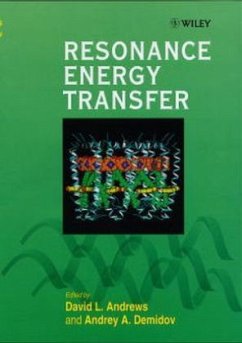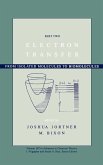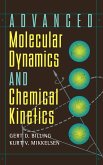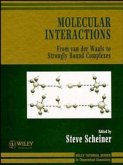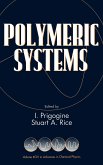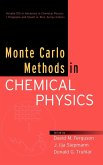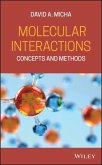David L Andrews, Andrey A Demidov
Resonance Energy Transfer
Herausgegeben von Andrews, David L.; Demidov, Andrey A.
David L Andrews, Andrey A Demidov
Resonance Energy Transfer
Herausgegeben von Andrews, David L.; Demidov, Andrey A.
- Gebundenes Buch
- Merkliste
- Auf die Merkliste
- Bewerten Bewerten
- Teilen
- Produkt teilen
- Produkterinnerung
- Produkterinnerung
Despite major advances and a wide range of interest in the field across chemistry, the medical sciences and biophysics, there have been very few up-to-date books on the subject. Bringing together the latest information and advances on this topic, this book provides a broad, yet detailed view of both theory and applications.
Die Übertragung elektronischer Energie zwischen Molekülen oder verschiedenen Positionen desselben Moleküls spielt eine wichtige Rolle in der modernen Chemie, der Medizin und der Biophysik. Bisher gab es kein Buch, das Grundprinzipien und Anwendungen dieses Gebietes…mehr
Andere Kunden interessierten sich auch für
![Electron Transfer Electron Transfer]() Joshua Jortner / M. Bixon (Hgg.)Electron Transfer600,99 €
Joshua Jortner / M. Bixon (Hgg.)Electron Transfer600,99 €![Advanced Molecular Dynamics and Chemical Kinetics Advanced Molecular Dynamics and Chemical Kinetics]() Gert Due BillingAdvanced Molecular Dynamics and Chemical Kinetics251,99 €
Gert Due BillingAdvanced Molecular Dynamics and Chemical Kinetics251,99 €![Electron Transfer Electron Transfer]() Joshua Jortner / M. Bixon (Hgg.)Electron Transfer600,99 €
Joshua Jortner / M. Bixon (Hgg.)Electron Transfer600,99 €![Molecular Interactions Molecular Interactions]() Steve Scheiner (Hrsg.)Molecular Interactions554,99 €
Steve Scheiner (Hrsg.)Molecular Interactions554,99 €![Polymeric Systems, Volume 94 Polymeric Systems, Volume 94]() I. Prigogine / Stuart A. Rice (Hgg.)Polymeric Systems, Volume 94568,99 €
I. Prigogine / Stuart A. Rice (Hgg.)Polymeric Systems, Volume 94568,99 €![Monte Carlo Methods in Chemical Physics, Volume 105 Monte Carlo Methods in Chemical Physics, Volume 105]() David M. Ferguson / J. Ilja Siepmann / Donald G. Truhlar (Hgg.)Monte Carlo Methods in Chemical Physics, Volume 105606,99 €
David M. Ferguson / J. Ilja Siepmann / Donald G. Truhlar (Hgg.)Monte Carlo Methods in Chemical Physics, Volume 105606,99 €![Molecular Interactions Molecular Interactions]() David MichaMolecular Interactions190,99 €
David MichaMolecular Interactions190,99 €-
-
-
Despite major advances and a wide range of interest in the field across chemistry, the medical sciences and biophysics, there have been very few up-to-date books on the subject. Bringing together the latest information and advances on this topic, this book provides a broad, yet detailed view of both theory and applications.
Die Übertragung elektronischer Energie zwischen Molekülen oder verschiedenen Positionen desselben Moleküls spielt eine wichtige Rolle in der modernen Chemie, der Medizin und der Biophysik. Bisher gab es kein Buch, das Grundprinzipien und Anwendungen dieses Gebietes gleichermaßen umfassend behandelte - eine Lücke, die jetzt geschlossen ist. Theoretische, mechanistische und praxisbezogene Aspekte kommen gleichermaßen zur Sprache. (04/99)
Hinweis: Dieser Artikel kann nur an eine deutsche Lieferadresse ausgeliefert werden.
Die Übertragung elektronischer Energie zwischen Molekülen oder verschiedenen Positionen desselben Moleküls spielt eine wichtige Rolle in der modernen Chemie, der Medizin und der Biophysik. Bisher gab es kein Buch, das Grundprinzipien und Anwendungen dieses Gebietes gleichermaßen umfassend behandelte - eine Lücke, die jetzt geschlossen ist. Theoretische, mechanistische und praxisbezogene Aspekte kommen gleichermaßen zur Sprache. (04/99)
Hinweis: Dieser Artikel kann nur an eine deutsche Lieferadresse ausgeliefert werden.
Produktdetails
- Produktdetails
- Verlag: Wiley & Sons
- 1. Auflage
- Seitenzahl: 488
- Erscheinungstermin: 4. Mai 1999
- Englisch
- Abmessung: 236mm x 160mm x 33mm
- Gewicht: 800g
- ISBN-13: 9780471987321
- ISBN-10: 0471987328
- Artikelnr.: 21247114
- Herstellerkennzeichnung
- Libri GmbH
- Europaallee 1
- 36244 Bad Hersfeld
- gpsr@libri.de
- Verlag: Wiley & Sons
- 1. Auflage
- Seitenzahl: 488
- Erscheinungstermin: 4. Mai 1999
- Englisch
- Abmessung: 236mm x 160mm x 33mm
- Gewicht: 800g
- ISBN-13: 9780471987321
- ISBN-10: 0471987328
- Artikelnr.: 21247114
- Herstellerkennzeichnung
- Libri GmbH
- Europaallee 1
- 36244 Bad Hersfeld
- gpsr@libri.de
David L. Andrews, School of Chemical Sciences, University of East Anglia, GB. Highly respected and has made major interesting contributions in the field. His works are very deep and illuminating. Professor Andrews has also published in condensed matter QED, though not to the same extent. One of his books has gone to a third edition, and another has been reprinted.
1. Resonance energy transfer in proteins
introduction
some basic considerations
a short history of FRET determinations
the components of the Foorster equation
quantum yield
determining spectral overlap
steady state or time-resolved measurements?
resonance energy transfer using intrinsic amino acids
homotransfer between intrinsic probes
heterotransfer
the range of distances determined by resonance energy transfer
precise location of resonance energy transfer probes
properties of probes
labeling specific residues in proteins
resonance energy transfer experiments using lanthanide ions
measurements in radially symmetrical systems
comparison with crystallographic distances
using resonance energy transfer to constrain molecular models
resonance energy transfer with single fluorophores: new wave experiments
intramolecular energy transfer in proteins bound to membranes
green fluorescent protein
resonance energy transfer and biosensors: a new and promising technique
shortcomings
the future of FRET
summary
dedication
acknowledgements
references. 2. Unified theory and radiative and raditionless energy transfer
introduction
background
the basis of the unified theory
spectral features
refraction and dissipation
dynamics of energy transfer between a pair of molecules in a dielectric medium
conclusion
appendix A: Heitler-MA method for analysis of the transition operator
Appendix B: modified approach to the transition operator
references. 3. Dynamics of radiative transport
introduction
overview of atomic and molecular radiative transport
the Holstein-Biberman equation
multiple scattering representation
stochastic approach
combined radiative and nonradiative transport
conclusion
appendix A: probablitity of emission of a photon between t + dt for an nth generation molecule
appendix B: depolarization factor for radiative transferaccording to classical electrodynamics
references. 4. Orientational aspects in pair energy transfer
introduction
Kappa-squared and probability, Kappa-squared and anisotropy
notes on the effects of order and motion
acknowledgements
references. 5. Polarization in molecular complexes with incoherent energy transfer
introduction
interaction of light with single molecules or chromophores
bichromophore molecular complexes
trichromophore complexes
multichromophore complexes with C3 symmetry
conclusion
appendix A
appendix B
appendix C
appendix D
references. 6. Theory of coupling in multichromophoric systems
introduction
reactant and product states: LMO model
the origin of coupling matrix elements
paradigmatic results
coulombic coupling
superexchange
interpretation of steady state spectra
calculation of couplings
acknowledgements
references. 7. Exciton annihilation in molecular aggregates
introduction
theory
applications
discussion
acknowledgements
references. 8. Energy transfer and localization: applications to photosynthetic systems
introduction
optical properties of dimers and aggregates
energy and localization in antenna complexes and reaction centers
acknowledgements
references. 9.Excitation energy transfer in photosynthesis
introduction
the structure of light-harvesting complexes
the mechanism of energy transfer and trapping in photosynthesis
dynamics of excitation energy transfer
conclusions
acknowledgements
references. 10. The Fenna-Matthews-Olson protein: a strongly coupled photosynthetic antenna
introduction
steady state spectroscopy
FMO exciton simulations
FMO primary processes
epilog and future prospects
acknowledgements
references. 11. Use of a Monte carlo method in the problem of energy migration in molecular complexes
introduction
an illustration of Monte Carlo calculations in the problem of fluorescence decay
energy transfer in CME: major algorithm
applications of monte Carlo simulations
conclusion
acknowledgements
references. Index
introduction
some basic considerations
a short history of FRET determinations
the components of the Foorster equation
quantum yield
determining spectral overlap
steady state or time-resolved measurements?
resonance energy transfer using intrinsic amino acids
homotransfer between intrinsic probes
heterotransfer
the range of distances determined by resonance energy transfer
precise location of resonance energy transfer probes
properties of probes
labeling specific residues in proteins
resonance energy transfer experiments using lanthanide ions
measurements in radially symmetrical systems
comparison with crystallographic distances
using resonance energy transfer to constrain molecular models
resonance energy transfer with single fluorophores: new wave experiments
intramolecular energy transfer in proteins bound to membranes
green fluorescent protein
resonance energy transfer and biosensors: a new and promising technique
shortcomings
the future of FRET
summary
dedication
acknowledgements
references. 2. Unified theory and radiative and raditionless energy transfer
introduction
background
the basis of the unified theory
spectral features
refraction and dissipation
dynamics of energy transfer between a pair of molecules in a dielectric medium
conclusion
appendix A: Heitler-MA method for analysis of the transition operator
Appendix B: modified approach to the transition operator
references. 3. Dynamics of radiative transport
introduction
overview of atomic and molecular radiative transport
the Holstein-Biberman equation
multiple scattering representation
stochastic approach
combined radiative and nonradiative transport
conclusion
appendix A: probablitity of emission of a photon between t + dt for an nth generation molecule
appendix B: depolarization factor for radiative transferaccording to classical electrodynamics
references. 4. Orientational aspects in pair energy transfer
introduction
Kappa-squared and probability, Kappa-squared and anisotropy
notes on the effects of order and motion
acknowledgements
references. 5. Polarization in molecular complexes with incoherent energy transfer
introduction
interaction of light with single molecules or chromophores
bichromophore molecular complexes
trichromophore complexes
multichromophore complexes with C3 symmetry
conclusion
appendix A
appendix B
appendix C
appendix D
references. 6. Theory of coupling in multichromophoric systems
introduction
reactant and product states: LMO model
the origin of coupling matrix elements
paradigmatic results
coulombic coupling
superexchange
interpretation of steady state spectra
calculation of couplings
acknowledgements
references. 7. Exciton annihilation in molecular aggregates
introduction
theory
applications
discussion
acknowledgements
references. 8. Energy transfer and localization: applications to photosynthetic systems
introduction
optical properties of dimers and aggregates
energy and localization in antenna complexes and reaction centers
acknowledgements
references. 9.Excitation energy transfer in photosynthesis
introduction
the structure of light-harvesting complexes
the mechanism of energy transfer and trapping in photosynthesis
dynamics of excitation energy transfer
conclusions
acknowledgements
references. 10. The Fenna-Matthews-Olson protein: a strongly coupled photosynthetic antenna
introduction
steady state spectroscopy
FMO exciton simulations
FMO primary processes
epilog and future prospects
acknowledgements
references. 11. Use of a Monte carlo method in the problem of energy migration in molecular complexes
introduction
an illustration of Monte Carlo calculations in the problem of fluorescence decay
energy transfer in CME: major algorithm
applications of monte Carlo simulations
conclusion
acknowledgements
references. Index
1. Resonance energy transfer in proteins
introduction
some basic considerations
a short history of FRET determinations
the components of the Foorster equation
quantum yield
determining spectral overlap
steady state or time-resolved measurements?
resonance energy transfer using intrinsic amino acids
homotransfer between intrinsic probes
heterotransfer
the range of distances determined by resonance energy transfer
precise location of resonance energy transfer probes
properties of probes
labeling specific residues in proteins
resonance energy transfer experiments using lanthanide ions
measurements in radially symmetrical systems
comparison with crystallographic distances
using resonance energy transfer to constrain molecular models
resonance energy transfer with single fluorophores: new wave experiments
intramolecular energy transfer in proteins bound to membranes
green fluorescent protein
resonance energy transfer and biosensors: a new and promising technique
shortcomings
the future of FRET
summary
dedication
acknowledgements
references. 2. Unified theory and radiative and raditionless energy transfer
introduction
background
the basis of the unified theory
spectral features
refraction and dissipation
dynamics of energy transfer between a pair of molecules in a dielectric medium
conclusion
appendix A: Heitler-MA method for analysis of the transition operator
Appendix B: modified approach to the transition operator
references. 3. Dynamics of radiative transport
introduction
overview of atomic and molecular radiative transport
the Holstein-Biberman equation
multiple scattering representation
stochastic approach
combined radiative and nonradiative transport
conclusion
appendix A: probablitity of emission of a photon between t + dt for an nth generation molecule
appendix B: depolarization factor for radiative transferaccording to classical electrodynamics
references. 4. Orientational aspects in pair energy transfer
introduction
Kappa-squared and probability, Kappa-squared and anisotropy
notes on the effects of order and motion
acknowledgements
references. 5. Polarization in molecular complexes with incoherent energy transfer
introduction
interaction of light with single molecules or chromophores
bichromophore molecular complexes
trichromophore complexes
multichromophore complexes with C3 symmetry
conclusion
appendix A
appendix B
appendix C
appendix D
references. 6. Theory of coupling in multichromophoric systems
introduction
reactant and product states: LMO model
the origin of coupling matrix elements
paradigmatic results
coulombic coupling
superexchange
interpretation of steady state spectra
calculation of couplings
acknowledgements
references. 7. Exciton annihilation in molecular aggregates
introduction
theory
applications
discussion
acknowledgements
references. 8. Energy transfer and localization: applications to photosynthetic systems
introduction
optical properties of dimers and aggregates
energy and localization in antenna complexes and reaction centers
acknowledgements
references. 9.Excitation energy transfer in photosynthesis
introduction
the structure of light-harvesting complexes
the mechanism of energy transfer and trapping in photosynthesis
dynamics of excitation energy transfer
conclusions
acknowledgements
references. 10. The Fenna-Matthews-Olson protein: a strongly coupled photosynthetic antenna
introduction
steady state spectroscopy
FMO exciton simulations
FMO primary processes
epilog and future prospects
acknowledgements
references. 11. Use of a Monte carlo method in the problem of energy migration in molecular complexes
introduction
an illustration of Monte Carlo calculations in the problem of fluorescence decay
energy transfer in CME: major algorithm
applications of monte Carlo simulations
conclusion
acknowledgements
references. Index
introduction
some basic considerations
a short history of FRET determinations
the components of the Foorster equation
quantum yield
determining spectral overlap
steady state or time-resolved measurements?
resonance energy transfer using intrinsic amino acids
homotransfer between intrinsic probes
heterotransfer
the range of distances determined by resonance energy transfer
precise location of resonance energy transfer probes
properties of probes
labeling specific residues in proteins
resonance energy transfer experiments using lanthanide ions
measurements in radially symmetrical systems
comparison with crystallographic distances
using resonance energy transfer to constrain molecular models
resonance energy transfer with single fluorophores: new wave experiments
intramolecular energy transfer in proteins bound to membranes
green fluorescent protein
resonance energy transfer and biosensors: a new and promising technique
shortcomings
the future of FRET
summary
dedication
acknowledgements
references. 2. Unified theory and radiative and raditionless energy transfer
introduction
background
the basis of the unified theory
spectral features
refraction and dissipation
dynamics of energy transfer between a pair of molecules in a dielectric medium
conclusion
appendix A: Heitler-MA method for analysis of the transition operator
Appendix B: modified approach to the transition operator
references. 3. Dynamics of radiative transport
introduction
overview of atomic and molecular radiative transport
the Holstein-Biberman equation
multiple scattering representation
stochastic approach
combined radiative and nonradiative transport
conclusion
appendix A: probablitity of emission of a photon between t + dt for an nth generation molecule
appendix B: depolarization factor for radiative transferaccording to classical electrodynamics
references. 4. Orientational aspects in pair energy transfer
introduction
Kappa-squared and probability, Kappa-squared and anisotropy
notes on the effects of order and motion
acknowledgements
references. 5. Polarization in molecular complexes with incoherent energy transfer
introduction
interaction of light with single molecules or chromophores
bichromophore molecular complexes
trichromophore complexes
multichromophore complexes with C3 symmetry
conclusion
appendix A
appendix B
appendix C
appendix D
references. 6. Theory of coupling in multichromophoric systems
introduction
reactant and product states: LMO model
the origin of coupling matrix elements
paradigmatic results
coulombic coupling
superexchange
interpretation of steady state spectra
calculation of couplings
acknowledgements
references. 7. Exciton annihilation in molecular aggregates
introduction
theory
applications
discussion
acknowledgements
references. 8. Energy transfer and localization: applications to photosynthetic systems
introduction
optical properties of dimers and aggregates
energy and localization in antenna complexes and reaction centers
acknowledgements
references. 9.Excitation energy transfer in photosynthesis
introduction
the structure of light-harvesting complexes
the mechanism of energy transfer and trapping in photosynthesis
dynamics of excitation energy transfer
conclusions
acknowledgements
references. 10. The Fenna-Matthews-Olson protein: a strongly coupled photosynthetic antenna
introduction
steady state spectroscopy
FMO exciton simulations
FMO primary processes
epilog and future prospects
acknowledgements
references. 11. Use of a Monte carlo method in the problem of energy migration in molecular complexes
introduction
an illustration of Monte Carlo calculations in the problem of fluorescence decay
energy transfer in CME: major algorithm
applications of monte Carlo simulations
conclusion
acknowledgements
references. Index

